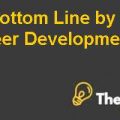
Context:
Resources in the FIS consultancy were adequate and competent which consisted of junior and senior team members. The leadership at the project was rather weak with both Rishi and Philly not aligned with the objective as they were trying to over-shadow top performers. The climate of trust within team members was low as stated in the case, Sidharth refused to share information with Sara. Performance evaluation system was installed but it was more inclined towards individual level performances rather than group performance which made each individual think of himself in the team rather than showing interest in completing group tasks (Richmond, 2000).
Process:
The common purpose of the team was to meet customer requirements for a specific project by developing curriculum and training material for the project. Specific goals were also aligned with the market of meeting goals. The project team basically suffered from low collective efficacy in the absence of a shared social or task relationship. Therefore, it effected the collective sharing of task focus which in turn affected the ability to competently and efficiently accomplish each task (Jones, 2008). Social loafing was on a high at the project with each team member trying to pass on their responsibilities to another team member and they were not willing to complete the task in a responsible manner. Conflict levels were also being seen with Rishi talking about team member’s performance behind their backs instead of sharing it with individuals.
Composition:
Abilities of each team memeber in the New Jersey project were good enough to complete the task with efficiency. Roles allocated to each team member were already defined while it was the duty of Rishi and Philly to make sure each group member in the team performed his or her role in the right manner, while meeting the deadline accordingly. The size of the team was also a reasonable one with 15 members who were allocated to complete the New Jersey project. Members were not flexible and were keen to help their acquaintances rather than everyone (Johnson, 2009).
Fiedler Contingency Model
The theory that effective groups depend on a proper match between a leader’s style of interacting with sub-ordinates and the degree to which the situation gives control to the leader is basically a Fiedler model. Principally, the leadership of Rishi can be evaluated on the scale project performance and the over all client satisfaction in relation to the task. In this case Rishi has not performed as he should have done with his team members. He should have been a good listener with unbiased opinions and should also have rated and evaluated each employee on the scale of his performance and credibility. Over here the performance of Rishi and Philly is a questionable because both of them have been very biased and least concerned about their team’s overall performance (Coleman, 2012).
Key Decision Criteria
| Decision Criteria | Unbiased Leadership | 360 degree appraisal system
|
Knowledge management
|
Functional team
|
| Company reputation | 01 | 00 | 00 | 00 |
| Increase sales | 00 | 01 | 01 | 01 |
| Motivated Employees | 01 | 01 | 01 | 01 |
| Meet deadlines | 00 | 00 | 01 | 01 |
| Improved Communication | 01 | 01 | 01 | 01 |
| Total | 03 | 03 | 04 | 04 |
Evaluation of Alternatives
Unbiased leadership:
As the case states Rishi and Philly both were biased while making decisions. They were in fact more focused on helping out their companions and favor them. The situation got worse and it turned out to be a biased one because Rishi presented the first draft of report presented by Sara to the client although the practice at the company was to review it further before passing it to others. If unbiased leadership is encouraged where a charismatic leader takes over from Rishi and other such leaders then the reputation of the company will definitely improve. The current situation where client was unsatisfied with the overall project would becomesatisfied. With satisfied clients and unbiased leaders who can drive the best out of each individual, the company can increase its overall sales, which have already expanded out of India. But if leaders are charismatic and real drivers of motivation then it can even further enhance each individual’s performance at the project. Once leaders are unbiased, the communication within teams will also improve that will make the atmosphere convenient for sharing information with trust when working on a similar project (Castronovo, 2010)....................................
This is just a sample partial case solution. Please place the order on the website to order your own originally done case solution.













